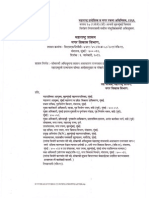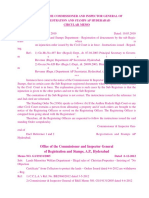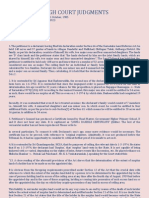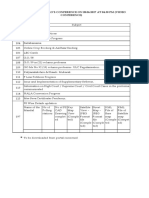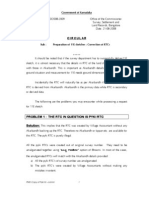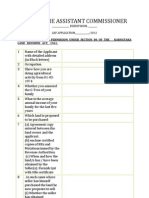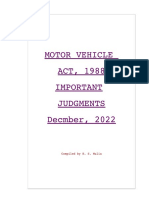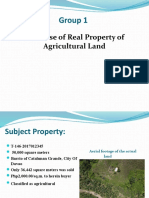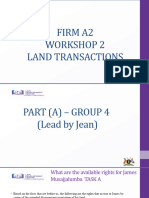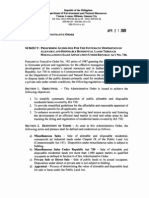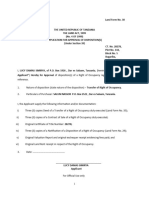What Is Pahani
What Is Pahani
Uploaded by
sathyanarayanabsCopyright:
Available Formats
What Is Pahani
What Is Pahani
Uploaded by
sathyanarayanabsOriginal Title
Copyright
Available Formats
Share this document
Did you find this document useful?
Is this content inappropriate?
Copyright:
Available Formats
What Is Pahani
What Is Pahani
Uploaded by
sathyanarayanabsCopyright:
Available Formats
What is Pahani(RTC) ?
Pahani(RTC) is a very important revenue records, as it contains details of land such as owners' details, area, assessment, water rate, soil type, nature of possession of the Land, Liabilities, Tenancy and Crops grown, etc. Why is Pahani required ? Pahani is required for various purposes: 1. To know the genuiness of seller(owner) when land is being purchased. 2. It is required at Sub-Register's office when sale transaction is being done 3. To raise the farm credit / loan from the Bank. 4. Court needs Pahani in case of Civil litigation. 5. For personal purpose." What does Pahani contain? Pahani contains valuable data related to piece of Land. It has the following information : 1. Survey Number and Hissa Number of Land. 2. Total Land under the Pahani. 3. Land Revenue details. 4. Land Owner's name with Extents and Khatha Number. 5. The way land is acquired by the owner. 6. Government/Public rights on the Land. 7. Liabilities of the Owners on the Land. 8. Classification of the Soil. 9. Number of Trees. 10. Source of irrigation and area irrigated. 11. Cultivators Details. 12. Utilisation of land under various categories. 13. Details of Crops grown season-wise. 14. Details of Mixed Crops. How to get the Pahani ? One can get the signed copy of computerized PAHANI from PAHANI CENTRE, set up at the Tahsildar Office, instantaneously by paying Rs.15.00. If he is unable to come to Taluk office, it can be collected by paying Rs.15.00 to Village Accountant / Revenue Inspector, who inturn will collect computerized PAHANI from PAHANI CENTRE and hand it over. How is the computerised RTC different from manual RTC ? There is absolutely no difference in the contents of computerised RTC and manual RTC. However, the computerised RTC is neat and easily readable and understandable as details are printed in the respective Columns. Further it cannot be tampered easily."
What are the benefits of computerisation to the Public ? The Public will have lots of benefits from computerisation. The whole process of updation of Land Records will be transparent. The following are the benefits :
a. Farmer can collect his land records related documents from PAHANI CENTRE instantaneously by paying Rs.15.00. b. Public can request Revenue Department to carry out the mutation on the land as per their transactions and collect the acknowledgement for that. c. Farmer can come and see the status of 'mutation requested' by him and status of 'mutation-in-process' on his land. d. At TOUCH SCREEN KIOSK the Public can view the land records documents, status of mutation and various other reports. What happens if I take manually written RTC in Computerised Taluk ? Government of Karnataka has issued the order saying that in Computerised taluka, only computer generated RTC's are valid for all legal purposes and that handwritten RTC will not be recognized by Government" What is Mutation ? Mutation is a process through which Owner's name or his particulars like liabilities get changed because of some type of transactions. The type of transaction may be one of the following: 1. J-Slip-Sale through registered deed. 2. Inheritance - Change of Ownership because of death of the Owner. 3. Division of Land within the Family. 4. Pledge / Release - Change in liabilities because of loan from bank or repayment to bank. 5. Court Decree - Based on the Court Order. 6. Alienation - Conversion of land from agricultural to other purposes. 7. Acquisition by Government for Public purpose. 8. Grant of Land by Government to Poor People." Is there any difference in Land Records Updation Process after Computerisation ? NO. Updation process of Land Records is same in both Computerised and Manual systems. All the rules of Karnataka Land Revenue Act are followed as it is, in case of Computerised system with some added precautions."
When does the Owner name and his details Change ? The change in Owner name and his details will take place when one of the following transactions occurs : a. J-Slip - Sale transaction takes place at SRO. b. Inheritance - Death of the Owner. c. Division of Land within Family Members. d. Court Decree - Order of the court. e. Grant by the Government. f. Alienation for non-agricultural purposes. g. Acquisition by Government. h. Podi - Division of RTC into 2 or more. i. Pledge/Release of the Land with / from banks." How to bring New Owner's name or change the owner's details in the RTC ?
The Owners of the land will change because of purchase transaction, Inheritance, Division, Grant by Government, Court Decree. When one of these takes place, NEW OWNERS should approach the Revenue Department with the required document to incorporate their names. They can request for the same at the PAHANI CENTRE and collect the acknowledgement. Similarly when loan is taken or repayment is done, to change the liabilities details, Owner can submit the request at the PAHANI CENTRE with required documents." What is Objection and how to raise it ? Objection is a complaint about the transaction. That is, if some transaction comes for change of Ownership, to the Revenue Department, before accepting as it is, department serves the notice to the interested parties and puts in the CHAVADI. If anybody feels it is illegal transaction or feels his rights on the land is in trouble, he can raise the Objection. He has to give a written Objection within 30 days from notice served date to Village Accountant / Revenue Inspector / Taluk Office."
When does crop data change in RTC ?" Crop details will be written on the RTC once or twice in a year, depending upon the seasons. The Crops information will be written by Village Accountant after inspecting the field." What to do if crops information is wrong in RTC ? One can lodge a request to change the crop information on the PAHANI at the PAHANI CENTRE / Village Accountant. The same will be changed after " & " verification by Village Accountant / Revenue Inspector."
GOVERNMENT OF KARNATAKA Karnataka Government Secretariat, M.S.Building, Bangalore, Circular Number No. RD 79 MRR 2002 S l No 1860/Section RTC Subject Reg- Co-parceners
Dated: 20th February 2003.
CIRCULAR There is some confusion in recording the name of the purchaser in the Mutation Register on the sale of undivided interest of one of the Co-parceners of the land. Some Revenue Inspectors are insisting upon the landholder to first get the land partitioned and then approach for mutation; whereas some Revenue Inspectors are effecting mutations by recording the name of the purchaser and even giving separate rights to the purchaser by effecting phodi in respect of the land purchased by him. In a case reported in ILR 1999 KAR 1484 the Hon'ble High Court has held as follows: "No doubt, as pointed by Shri Adhyapak the respondent 3 and 4 acquire the undivided interest of the 2nd respondent in respect of the land bearing sy.no.772/2. It is well settled that so long as the partition of the family properties does not take place, what the respondents 3 and 4 acquire in the land in question is only the undivided interest of the 2nd respondent. Under these circumstances, it was not permissible for the Tahsildar to enter the name of respondents 3 and 4 in respect of the land in question on the basis of the sale deed Annexure A and give separate sub-numbers as has been done in Annexure-E. If the respondents 3 and 4 have acquired right, title and interest of the 2nd respondent in respect of the land in question, the remedy open to the respondents 3 and 4 is to seek partition of the family properties. Till that is not done, it is not permissible for the Revenue Authorities to enter the name of the purchaser in respect of the joint family properties". It, therefore, implies that it is not correct for the Revenue Department to enter the name of purchaser in such cases where one of the Co-parceners sells his undivided interest. The purchaser will have to seek for partition of the family properties. Till it is done, revenue authorities should not enter name of the purchaser in respect of joint family properties in the mutation register. However, if all the joint holders agree to sell a portion of their joint property to a purchaser then the authorities can certainly enter the name of the purchaser in respect of the extent purchased by him. In such cases the remaining property continued to be joint in the name of the joint owners. Further, if one of the Co-parceners sells his undivided interest with the consent of all the other joint owners then his name can be removed and the name of the purchaser can be inserted. To illustrate these points following examples are given: Let us presume there are 3 joint owners holding 6 acres of land. If all of them jointly sell one acre of land to D then it is permissible for the revenue authorities to mutate one acre of land in favour of D. Then RTC would be as follows: A, B, C 5 acres (jointly owned) D 1 acre In the second case, if C sells away his portion of land, which, for the sake of argument, say one and half acre (as agreed by all 3 owners) then RTC would look as follows: A, B 4.20 acres (jointly owned) D 1.20 acre In both these cases it may noted that the consent of the other joint owners either at the time of executing sale deed or at the time of effecting mutation is necessary.
Above guidelines be kept in mind by all the concerned. This Circular is also available at the Revenue Department Internet site http://www.revdept.kar.nic.in. (RAJEEV CHAWLA)
Additional Secretary to Government Revenue Department (Land Reforms) To, All Deputy Commissioners. Foot Notes For any suggestions / clarifications, please send mail to Mr. Rajeev Chawla (Additional Secretary)
You might also like
- Julians Park. Rushden, HertfordshireDocument20 pagesJulians Park. Rushden, HertfordshiremicromacromarketNo ratings yet
- New DCR 06 01 2012Document26 pagesNew DCR 06 01 2012pbharucha67% (3)
- Affidavit of Retention AreaDocument1 pageAffidavit of Retention AreaHarold Estacio100% (4)
- Gajuwaka House Committee ClearnessDocument2 pagesGajuwaka House Committee Clearnessmohan krishna100% (1)
- Brief Note On Ulc Lands RegularizationDocument2 pagesBrief Note On Ulc Lands RegularizationMani Sutapalli100% (3)
- G O Ms No 571 PDFDocument46 pagesG O Ms No 571 PDFanilkc9100% (2)
- GO Ms No 58 Revenue (Assignment-I) Dept Dated 30-12-2014Document2 pagesGO Ms No 58 Revenue (Assignment-I) Dept Dated 30-12-2014sravanNo ratings yet
- Acts Adoption To TelanganaDocument47 pagesActs Adoption To TelanganaBansi Bhukya0% (1)
- G.O.Ms No 117Document2 pagesG.O.Ms No 117Chandrra Neeli100% (1)
- Parawise Remarks PDFDocument40 pagesParawise Remarks PDFJaya Prakash Kambampati100% (1)
- Bhoomi Kaveri Mojini IntegrationDocument154 pagesBhoomi Kaveri Mojini Integrationsachingowda100% (1)
- Integration of Phodi Process With Mutation in Bhoomi: (Simultaneous Updation of Spatial & Textual LR)Document19 pagesIntegration of Phodi Process With Mutation in Bhoomi: (Simultaneous Updation of Spatial & Textual LR)Sudhakar GanjikuntaNo ratings yet
- History of Urban SettlementsDocument114 pagesHistory of Urban SettlementsMary Ann Figueras100% (1)
- Lecture 8 Land Use Controls (MS PowerPoint)Document33 pagesLecture 8 Land Use Controls (MS PowerPoint)minani marcNo ratings yet
- Karnataka RTC Entry Instruction CircularDocument1 pageKarnataka RTC Entry Instruction CircularSridhara babu. N - ಶ್ರೀಧರ ಬಾಬು. ಎನ್100% (1)
- Records of Rights (ROR-1B) - (Telangana) Objective:: Land TypeDocument3 pagesRecords of Rights (ROR-1B) - (Telangana) Objective:: Land TypeDinakaar SNo ratings yet
- Land Revenue Manual 20200629152357Document97 pagesLand Revenue Manual 20200629152357Kamal Ashok100% (1)
- AP Registration RulesDocument145 pagesAP Registration RulesRajesh KarriNo ratings yet
- D - CCLAACTS - MANUALSSurveyThe Survey and Boundaries Act of 1923 PDFDocument9 pagesD - CCLAACTS - MANUALSSurveyThe Survey and Boundaries Act of 1923 PDFNaveen Kumar RudhraNo ratings yet
- 3 - The AP Survey Manual - Version IIIDocument120 pages3 - The AP Survey Manual - Version IIIPlanningsecretary 02No ratings yet
- 1st RTI Appeal For Audit StatementDocument1 page1st RTI Appeal For Audit StatementAdv. Ibrahim DeshmukhNo ratings yet
- The A.p.assigned Lands (Prohibition of Transfers) ACT1977Document23 pagesThe A.p.assigned Lands (Prohibition of Transfers) ACT1977sunchitNo ratings yet
- MEMORANDUM OF DEPOSIT OF TITLE DEEDS UBI LatestDocument3 pagesMEMORANDUM OF DEPOSIT OF TITLE DEEDS UBI Latestsreenivas_miryala100% (1)
- Faq - Published by Karnataka Government Explaining Survey WorksDocument6 pagesFaq - Published by Karnataka Government Explaining Survey WorksSridhara babu. N - ಶ್ರೀಧರ ಬಾಬು. ಎನ್100% (1)
- Cheque Petition 232 2010 3rd Petitioner F.SDocument6 pagesCheque Petition 232 2010 3rd Petitioner F.SVemula Venkata PavankumarNo ratings yet
- Apartments Act NoteDocument4 pagesApartments Act NoteAnonymous 0ppGK23hNo ratings yet
- Commmisoner Report in ApDocument7 pagesCommmisoner Report in ApMOHAN REDDYNo ratings yet
- AP Rights in Land Pattadar Pass Books Act 1971Document45 pagesAP Rights in Land Pattadar Pass Books Act 1971Nithin RoyNo ratings yet
- A.P Rights in Land and Pattadar Pass Books PDFDocument48 pagesA.P Rights in Land and Pattadar Pass Books PDFsubbarao_rayavarapu100% (1)
- Civil Rules of Practice PDFDocument224 pagesCivil Rules of Practice PDFJOHNNo ratings yet
- The Karnataka Scheduled Castes, Scheduled Tribes and Other Backward Classes (Reservation of Seats in Educational Institutions and of Appointment or Posts in The Services Under The State Act, 1994.Document7 pagesThe Karnataka Scheduled Castes, Scheduled Tribes and Other Backward Classes (Reservation of Seats in Educational Institutions and of Appointment or Posts in The Services Under The State Act, 1994.Sridhara babu. N - ಶ್ರೀಧರ ಬಾಬು. ಎನ್No ratings yet
- MemoNo 12010 10032010 PDFDocument42 pagesMemoNo 12010 10032010 PDFnizamuddinNo ratings yet
- Karnataka Surveyors Diary CompiliationDocument30 pagesKarnataka Surveyors Diary CompiliationSridhara babu. N - ಶ್ರೀಧರ ಬಾಬು. ಎನ್100% (7)
- Telangana District Court 2024 CalendarDocument1 pageTelangana District Court 2024 Calendargoyal1982No ratings yet
- Mysore (Personal and Miscellaneous) Inams Abolition Act, 1954Document30 pagesMysore (Personal and Miscellaneous) Inams Abolition Act, 1954sunandeniNo ratings yet
- GO-111-Vattinagulapally JudgementDocument25 pagesGO-111-Vattinagulapally JudgementMadhan RavindranNo ratings yet
- Telangana State Land Acquisition (Consent Award, Voluntary Acquisition and Lump Sum Payment Towards Rehabilitation and Resettlement) Rules, 2017Document11 pagesTelangana State Land Acquisition (Consent Award, Voluntary Acquisition and Lump Sum Payment Towards Rehabilitation and Resettlement) Rules, 2017lao100% (1)
- Land Ceiling of Agricultural Land How Calculated in Karnataka Explained by Karnataka High CourtDocument7 pagesLand Ceiling of Agricultural Land How Calculated in Karnataka Explained by Karnataka High CourtSridhara babu. N - ಶ್ರೀಧರ ಬಾಬು. ಎನ್100% (2)
- Section 109 Land Reforms Act - 1961Document3 pagesSection 109 Land Reforms Act - 1961maheshmrplegalisNo ratings yet
- Durga Sale Deed 1Document7 pagesDurga Sale Deed 1Durga DurgaNo ratings yet
- Written Arguments Filed in Case of Religious and Charitable Inam LandDocument54 pagesWritten Arguments Filed in Case of Religious and Charitable Inam LandSridhara babu. N - ಶ್ರೀಧರ ಬಾಬು. ಎನ್No ratings yet
- D RangareddyweeklyVcUploads44 PDFDocument63 pagesD RangareddyweeklyVcUploads44 PDFtruenameNo ratings yet
- Karnataka Revenue Department Circulars Regarding Survey and Correction of RTC Entries - Value of p1-p2 Survey NumbersDocument10 pagesKarnataka Revenue Department Circulars Regarding Survey and Correction of RTC Entries - Value of p1-p2 Survey NumbersSridhara babu. N - ಶ್ರೀಧರ ಬಾಬು. ಎನ್100% (14)
- Section 80 Land Reforms Application Model Format To Seek Permission From Ac To Purchase Agricultural LandDocument3 pagesSection 80 Land Reforms Application Model Format To Seek Permission From Ac To Purchase Agricultural LandSridhara babu. N - ಶ್ರೀಧರ ಬಾಬು. ಎನ್80% (5)
- Land Acquisition-ANDHRA PRADESH PDFDocument43 pagesLand Acquisition-ANDHRA PRADESH PDFravi196No ratings yet
- Stepping Up of Pay: SL - No. Order No. DescriptionDocument4 pagesStepping Up of Pay: SL - No. Order No. DescriptionbyagniNo ratings yet
- Gift 1Document5 pagesGift 1ashok9705030066100% (1)
- B Venkateswaran VS P Bakthavatchalam PDFDocument4 pagesB Venkateswaran VS P Bakthavatchalam PDFM. NAGA SHYAM KIRANNo ratings yet
- Private Schools Inspection Format Ny MEODocument5 pagesPrivate Schools Inspection Format Ny MEOMIS Info100% (1)
- DR MVS IntervenerPetitionMainPetitionDocument38 pagesDR MVS IntervenerPetitionMainPetitionMuralidharan100% (2)
- Macp Important Judgments. December.2022Document220 pagesMacp Important Judgments. December.2022KIRAN VERMANo ratings yet
- Draft Counter-K. SasikumarDocument5 pagesDraft Counter-K. SasikumaradvpreetipundirNo ratings yet
- Revenue Handbook 4 (!) (B) 09Document173 pagesRevenue Handbook 4 (!) (B) 09Rakesh Chowdary80% (5)
- Fabrication of False Evidence May Take Place Outside The Court Though Used Inside The Court Hence Section 195 and 340 CRPC Not Applicable 2012 SCDocument2 pagesFabrication of False Evidence May Take Place Outside The Court Though Used Inside The Court Hence Section 195 and 340 CRPC Not Applicable 2012 SCSridhara babu. N - ಶ್ರೀಧರ ಬಾಬು. ಎನ್No ratings yet
- Powers of Divisional CommissionerS IN MAHARASHTRA STATEDocument30 pagesPowers of Divisional CommissionerS IN MAHARASHTRA STATEJoint Chief Officer, MB MHADA100% (2)
- Civil Pleading Plaint: Brief Facts of The CaseDocument14 pagesCivil Pleading Plaint: Brief Facts of The CaseAparna MuleNo ratings yet
- Agriculture Land Faqs: Adangal & Pahani FaqDocument3 pagesAgriculture Land Faqs: Adangal & Pahani Faqgangadhar81No ratings yet
- A Property or Land in India: Before PurchasingDocument7 pagesA Property or Land in India: Before Purchasingpinjala srinivasNo ratings yet
- 19 Ilb 042Document8 pages19 Ilb 042Devansh SinghNo ratings yet
- Record of RightDocument2 pagesRecord of RightAnand maratheNo ratings yet
- Transfer Process Agricultural Land Free PatentDocument2 pagesTransfer Process Agricultural Land Free Patentjay_viernes2563No ratings yet
- Transferofregistru 180926143820 190227173338Document79 pagesTransferofregistru 180926143820 190227173338RaghuNo ratings yet
- Frequently Asked Questions & Their AnswersDocument6 pagesFrequently Asked Questions & Their AnswersgladiatorranaNo ratings yet
- Purchase of Real Property of Agricultural Land: Group 1Document54 pagesPurchase of Real Property of Agricultural Land: Group 1Ana leah Orbeta-mamburamNo ratings yet
- Letter of Instruction No. 474, S. 1976Document3 pagesLetter of Instruction No. 474, S. 1976KIM COLLEEN MIRABUENANo ratings yet
- Guwahati Building Construction Byelaws 2014Document146 pagesGuwahati Building Construction Byelaws 2014Pranoy MayuriNo ratings yet
- The Battle of Life - Charles Dickens PDFDocument97 pagesThe Battle of Life - Charles Dickens PDFRoben DengNo ratings yet
- PDF Rule 7 Amp 8 CompressDocument22 pagesPDF Rule 7 Amp 8 CompressSylwynLeisterRonquilloNo ratings yet
- Project EDENDocument9 pagesProject EDENJohn Louie CarmenNo ratings yet
- Form 13 NoticeDocument3 pagesForm 13 Noticesabita basnetNo ratings yet
- FIRM A2 - LT (WORKSHOP 2) SlidesDocument38 pagesFIRM A2 - LT (WORKSHOP 2) SlideshmagandaNo ratings yet
- Draft Deed of Absolute SalesDocument2 pagesDraft Deed of Absolute SalesRonald AmanteNo ratings yet
- Dao 2009-05Document5 pagesDao 2009-05sorbisorbi100% (1)
- Tirupur Master PlanDocument247 pagesTirupur Master PlanadhiNo ratings yet
- 152 Suntay V CADocument3 pages152 Suntay V CAAnnie Carmeli AntonioNo ratings yet
- Acknowledgment Receipt 5Document2 pagesAcknowledgment Receipt 5Deil L. NaveaNo ratings yet
- Land Form No No 30Document2 pagesLand Form No No 30Shabnam KrisNo ratings yet
- Gazette Extracts Requesting For Special Ttles From May To July 2011Document71 pagesGazette Extracts Requesting For Special Ttles From May To July 2011MBUSA JOHNNo ratings yet
- Case Digest REPUBLIC v. ABOITIZDocument2 pagesCase Digest REPUBLIC v. ABOITIZAbeguel SebandalNo ratings yet
- Arh Rs.20: India Non JudicialDocument3 pagesArh Rs.20: India Non JudicialUmamaheswari RengasamyNo ratings yet
- Vidhana Soudha Layout Bangalore.J300642119Document3 pagesVidhana Soudha Layout Bangalore.J300642119Thripura TholdaNo ratings yet
- Ethopia Country Report Final1Document19 pagesEthopia Country Report Final1Beranu GudisaNo ratings yet
- Factors Affecting Urban Land Value in IndianDocument4 pagesFactors Affecting Urban Land Value in IndianAnubhuti AgrawalNo ratings yet
- 1 Govind Prashad Dhakal Policy and Practice of Urban Planning in Nepal A Case of Public Community Participation PDFDocument15 pages1 Govind Prashad Dhakal Policy and Practice of Urban Planning in Nepal A Case of Public Community Participation PDFLatip Kumar SharmaNo ratings yet
- Eagle Realty Corp. V RepublicDocument3 pagesEagle Realty Corp. V RepublicJerald AmbeNo ratings yet
- Narvasa vs. ImbornalDocument1 pageNarvasa vs. ImbornalBernadette Racadio100% (2)
- Partment of Agrarian Reform: Carper Lad Form No. 6Document1 pagePartment of Agrarian Reform: Carper Lad Form No. 6Mandia SiblaganNo ratings yet
- The Role of Government in Land Administration and Management in The PhilippinesDocument8 pagesThe Role of Government in Land Administration and Management in The PhilippinesFrancis Joseph GuevaraNo ratings yet
- Public Land Act ReviewerDocument6 pagesPublic Land Act ReviewerJoahnna Paula CorpuzNo ratings yet
- Residential Tenancy Agreement968279220240530Document4 pagesResidential Tenancy Agreement968279220240530Brian KabweNo ratings yet

